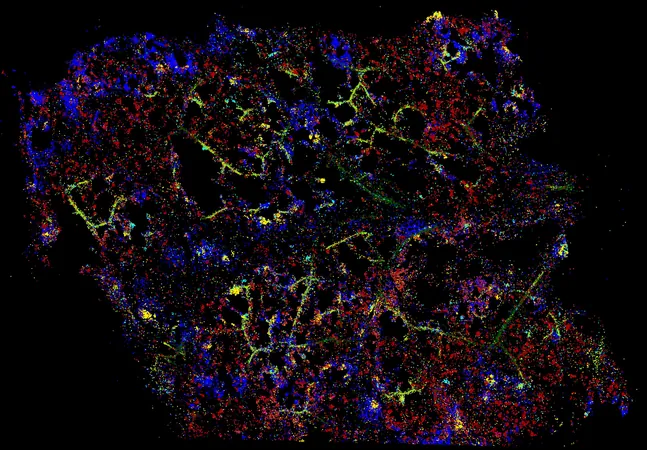
Revolutionary Discovery: How Plant Cells Become Immune Warriors Against Disease
2025-01-08
Author: John Tan
Introduction
In a surprising revelation, scientists from the Salk Institute have uncovered how plant cells harness their own defenses to combat infections, challenging our understanding of immunity in the plant kingdom. Unlike humans, who possess a mobile and specialized immune system brimming with diverse immune cells ready to spring into action against everything from cuts to colds, plants face a different reality. Their cells are anchored in place, forcing each individual cell to fend for itself while juggling essential tasks like photosynthesis and growth.
New Insights into Plant Immunity
The groundbreaking study, published on January 8, 2025, in the prestigious journal *Nature*, reveals that when plants encounter a threat, their cells switch roles, becoming what researchers have termed PRimary IMmunE Responder (PRIMER) cells. This innovative cell population acts as a communication hub, triggering the plant's immune responses.
The Role of Bystander Cells
Accompanying these PRIMER cells are 'bystander cells,' which play a crucial role in distributing the immune response signals throughout the plant's tissues. This intricate system allows plants to effectively coordinate their defense mechanisms even without a centralized immune system.
Professor Ecker's Insights
“Plants are in a constant battle for survival,” stated Professor Joseph Ecker, the study's senior author. “They don’t have the luxury of moving specialized immune cells around their body, so every cell must be ready to respond to attacks without neglecting its fundamental functions. Our research shines a light on how this remarkable adaptation works.”
Challenges Faced by Plants
The study highlights the challenges plants face from a variety of pathogens, such as bacteria sneaking through microscopic pores and fungi invading their cells. As stationary organisms, plants must rely on the ability of each cell to recognize and respond to these threats, prompting a complex interplay of immune responses across their structures.
Innovative Research Techniques
Utilizing advanced techniques like time-resolved single-cell multiomics and spatial transcriptomics, researchers managed to unravel the plant immune response in fine detail, registering the reactions within individual cells with unprecedented clarity. This high-resolution analysis revealed that PRIMER cells express a specific protein known as GT-3a, which likely serves as a crucial alert mechanism for surrounding cells to engage in defense.
Research Focus on Arabidopsis thaliana
The study focused on Arabidopsis thaliana, a model organism in plant research. By introducing bacterial pathogens to its leaves, researchers systematically documented how the plant's cells reacted during infection, uncovering the novel PRIMER immune state that arose in response to threats.
Significance of the Findings
The significance of these findings extends beyond basic research. With the looming challenges of antimicrobial resistance and climate change, understanding plant immunity has never been more critical. This newfound knowledge could help pave the way for developing resilient crops capable of withstanding environmental stressors.
Publicly Accessible Reference Database
The research team is eager to share their discoveries with the scientific community through a publicly accessible reference database, which will serve as a valuable tool for researchers worldwide. “Our atlas offers new insights into how individual plant cells tackle stress, ultimately laying the groundwork for more resilient agricultural practices,” Ecker pointed out.
Future Implications
With alarming shifts in climate patterns and an increase in pathogen evolution, harnessing this newfound understanding of plant immunity could be pivotal in ensuring the future health of plants and crops globally. As scientists continue to explore the complexity of plant immune responses, the potential for revolutionary advancements in agricultural sustainability looms large.

 Brasil (PT)
Brasil (PT)
 Canada (EN)
Canada (EN)
 Chile (ES)
Chile (ES)
 Česko (CS)
Česko (CS)
 대한민국 (KO)
대한민국 (KO)
 España (ES)
España (ES)
 France (FR)
France (FR)
 Hong Kong (EN)
Hong Kong (EN)
 Italia (IT)
Italia (IT)
 日本 (JA)
日本 (JA)
 Magyarország (HU)
Magyarország (HU)
 Norge (NO)
Norge (NO)
 Polska (PL)
Polska (PL)
 Schweiz (DE)
Schweiz (DE)
 Singapore (EN)
Singapore (EN)
 Sverige (SV)
Sverige (SV)
 Suomi (FI)
Suomi (FI)
 Türkiye (TR)
Türkiye (TR)
 الإمارات العربية المتحدة (AR)
الإمارات العربية المتحدة (AR)